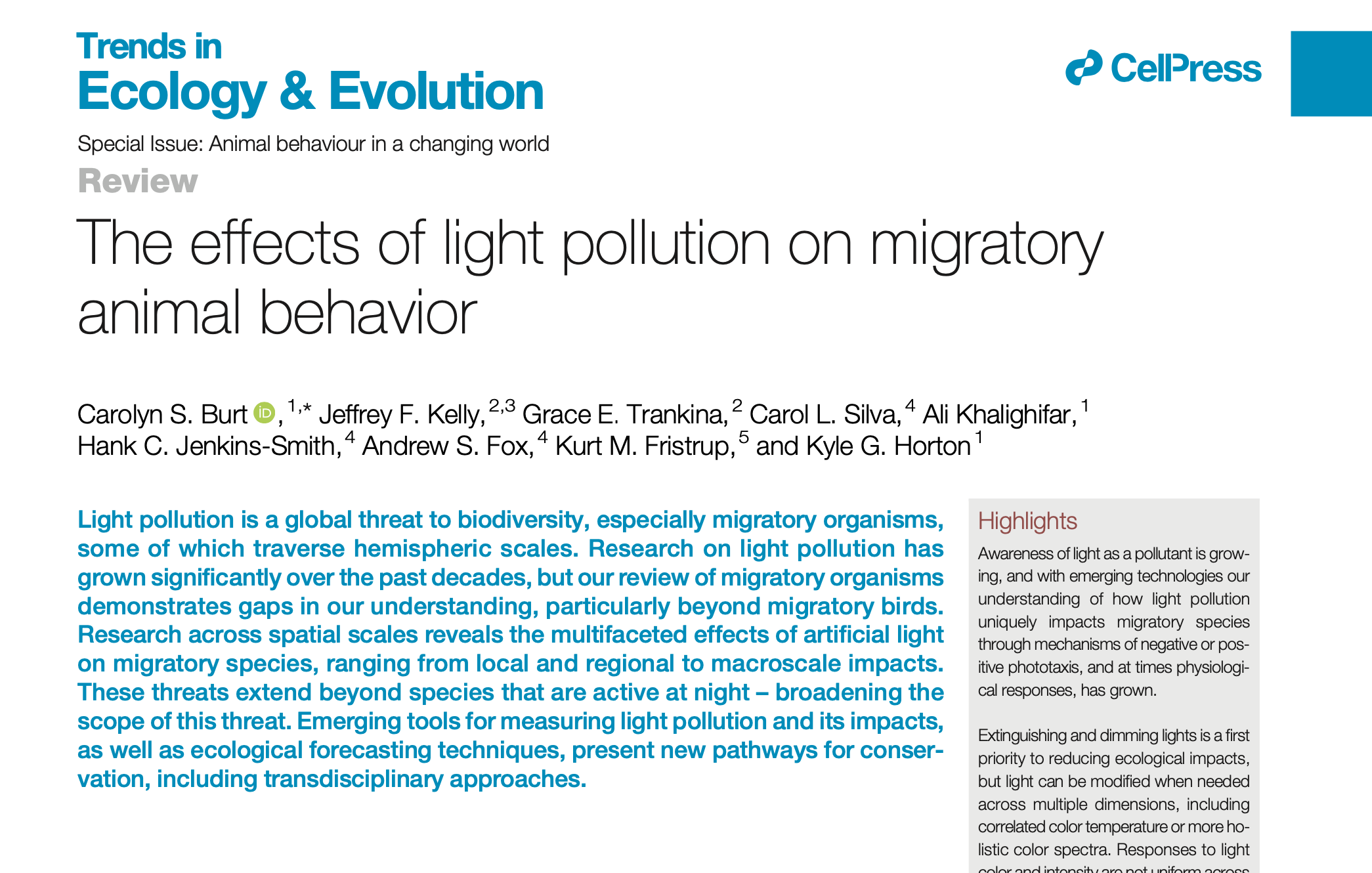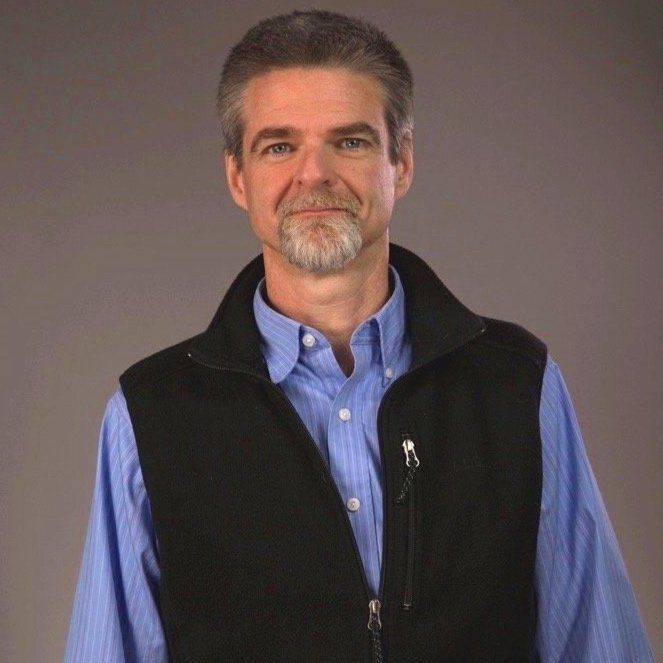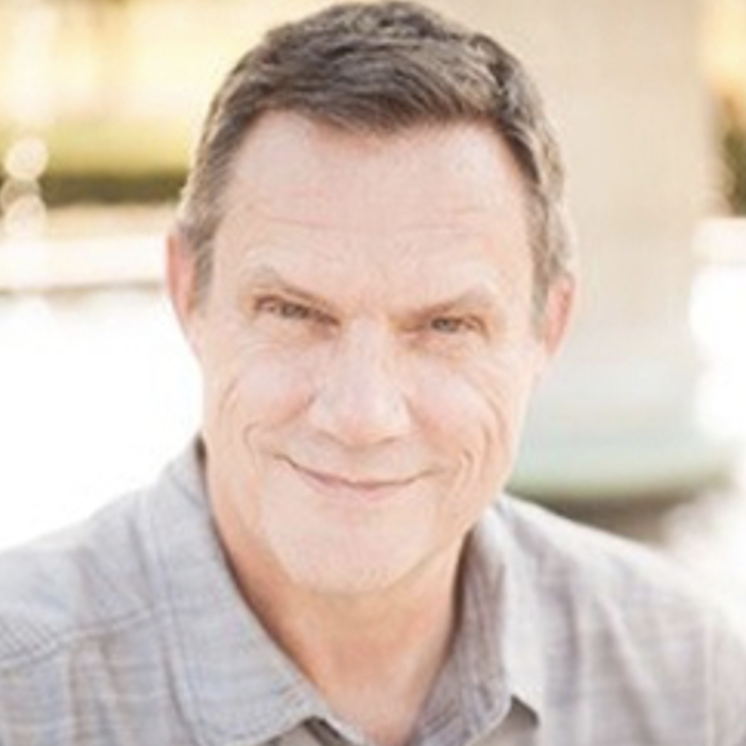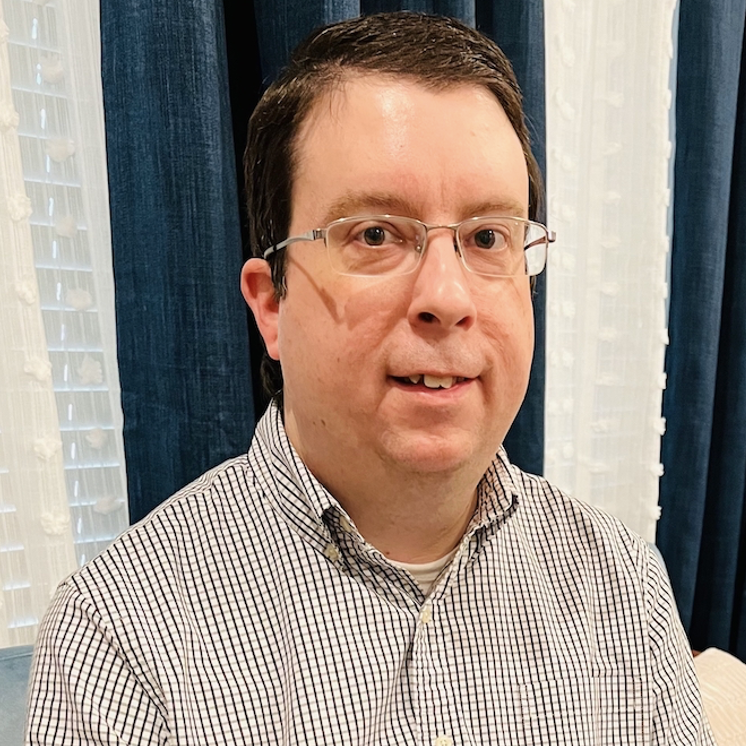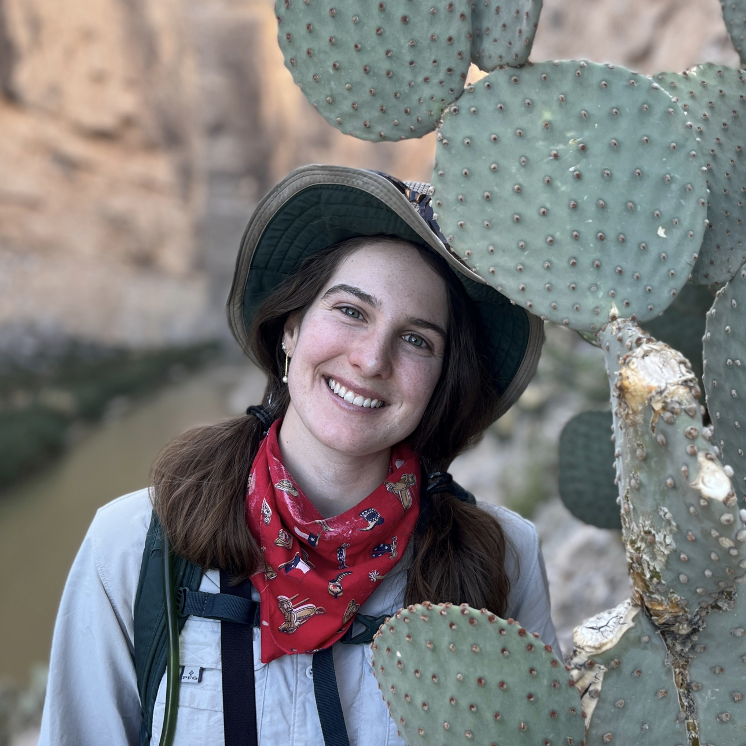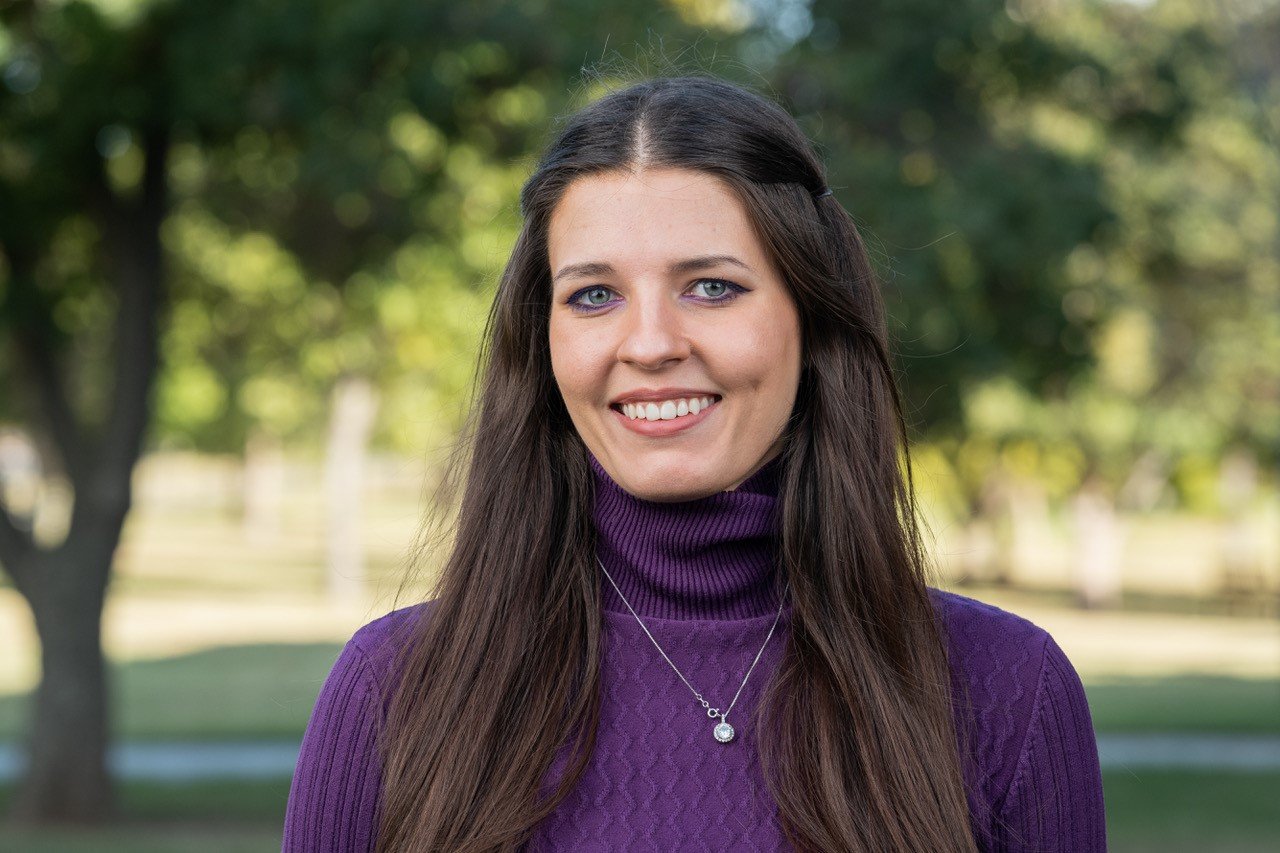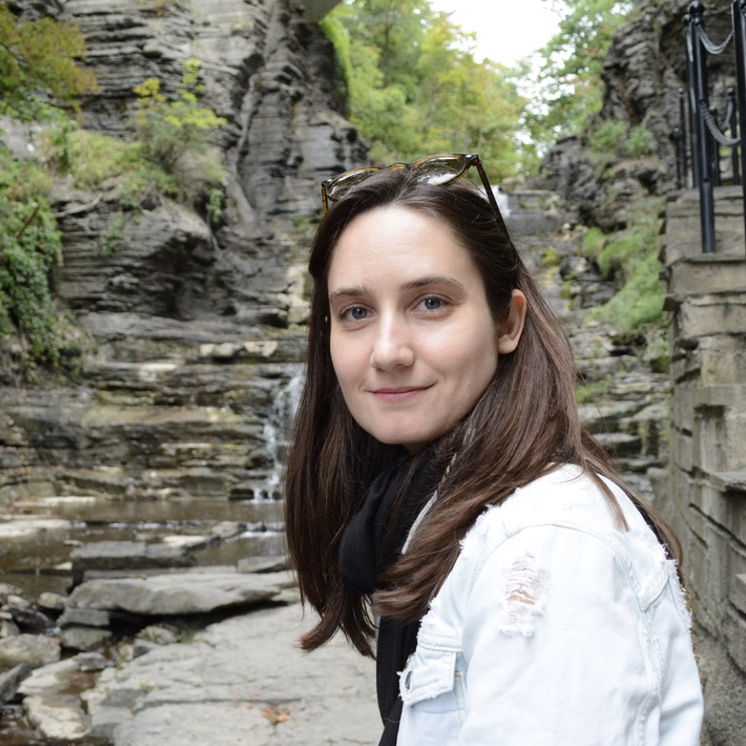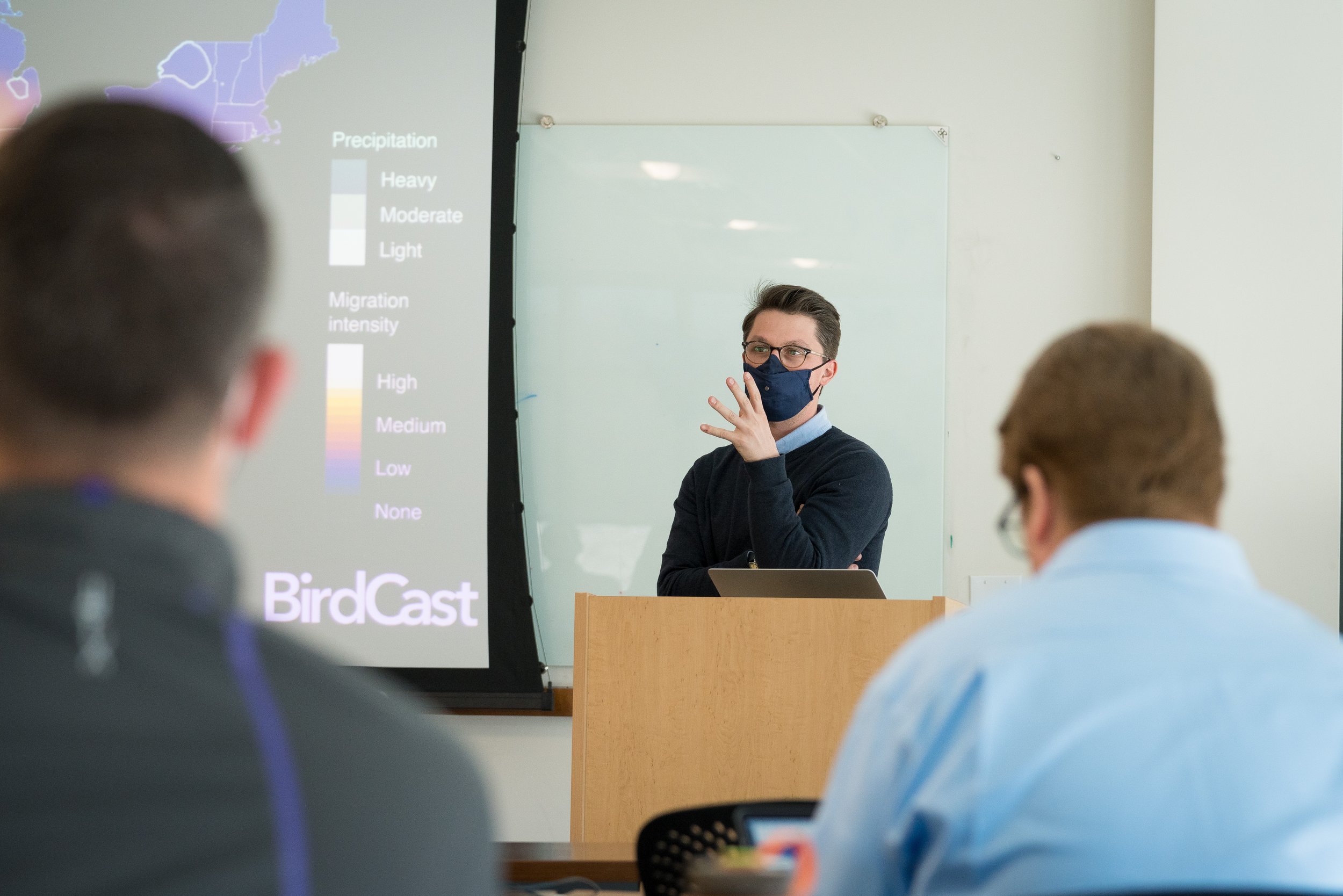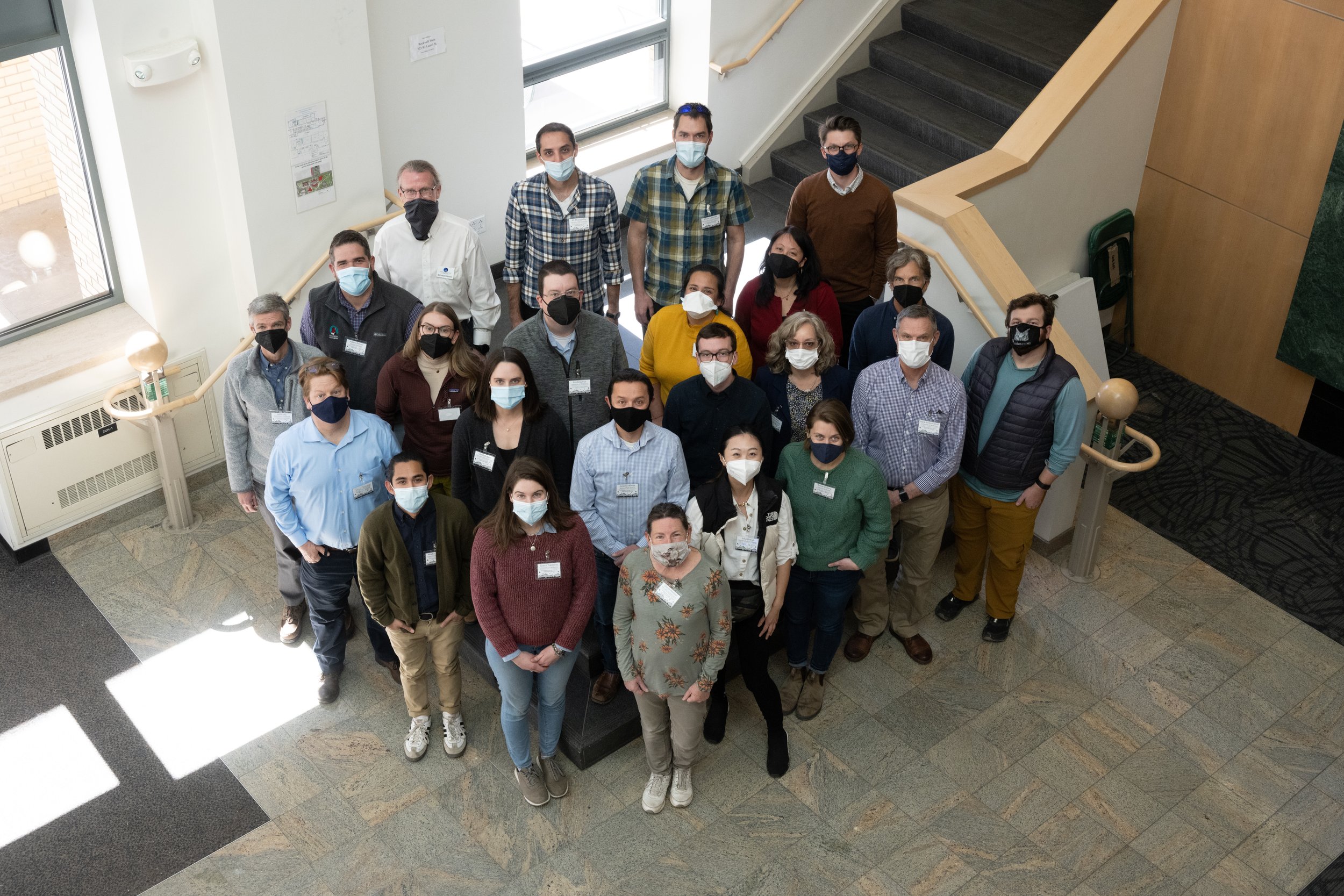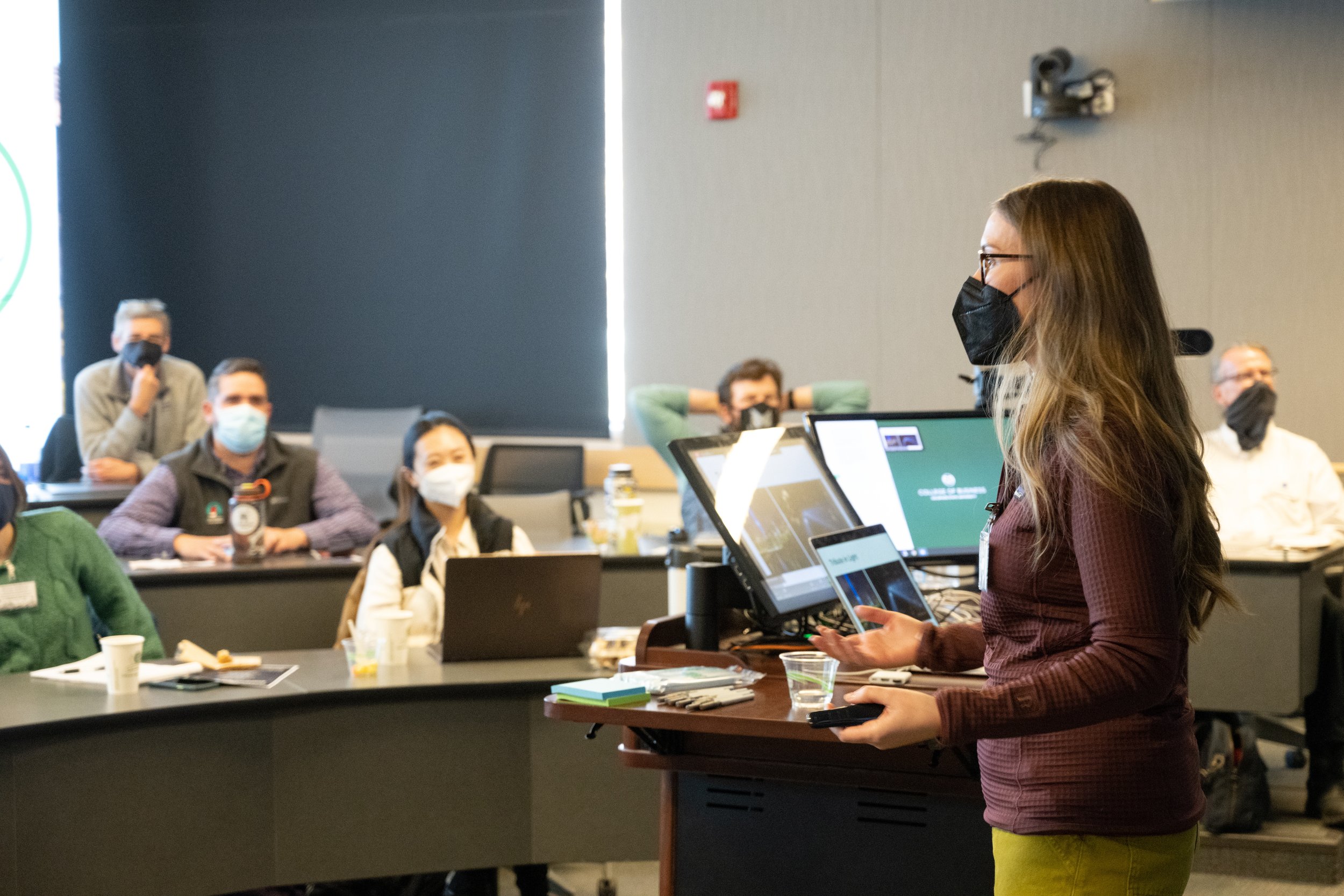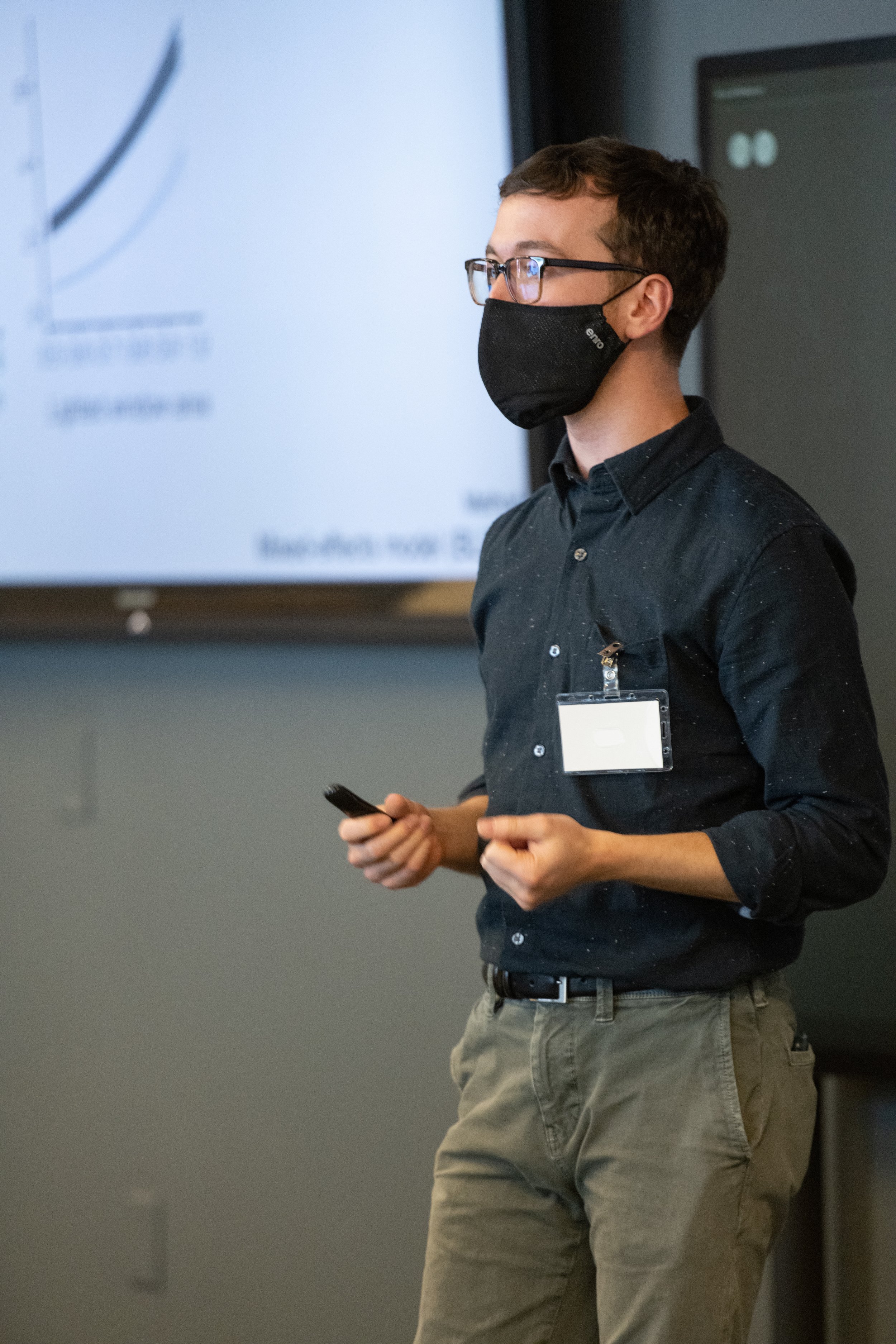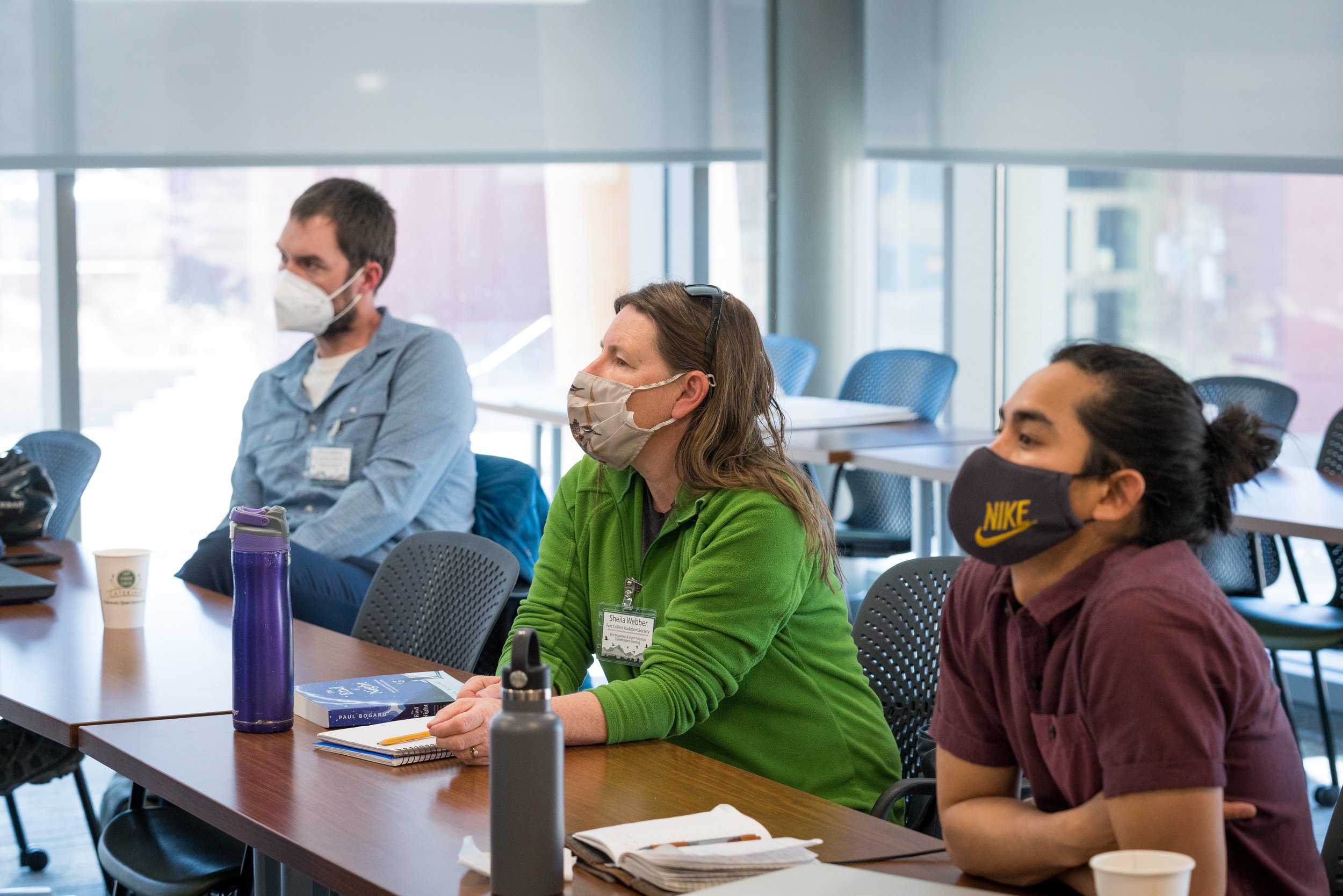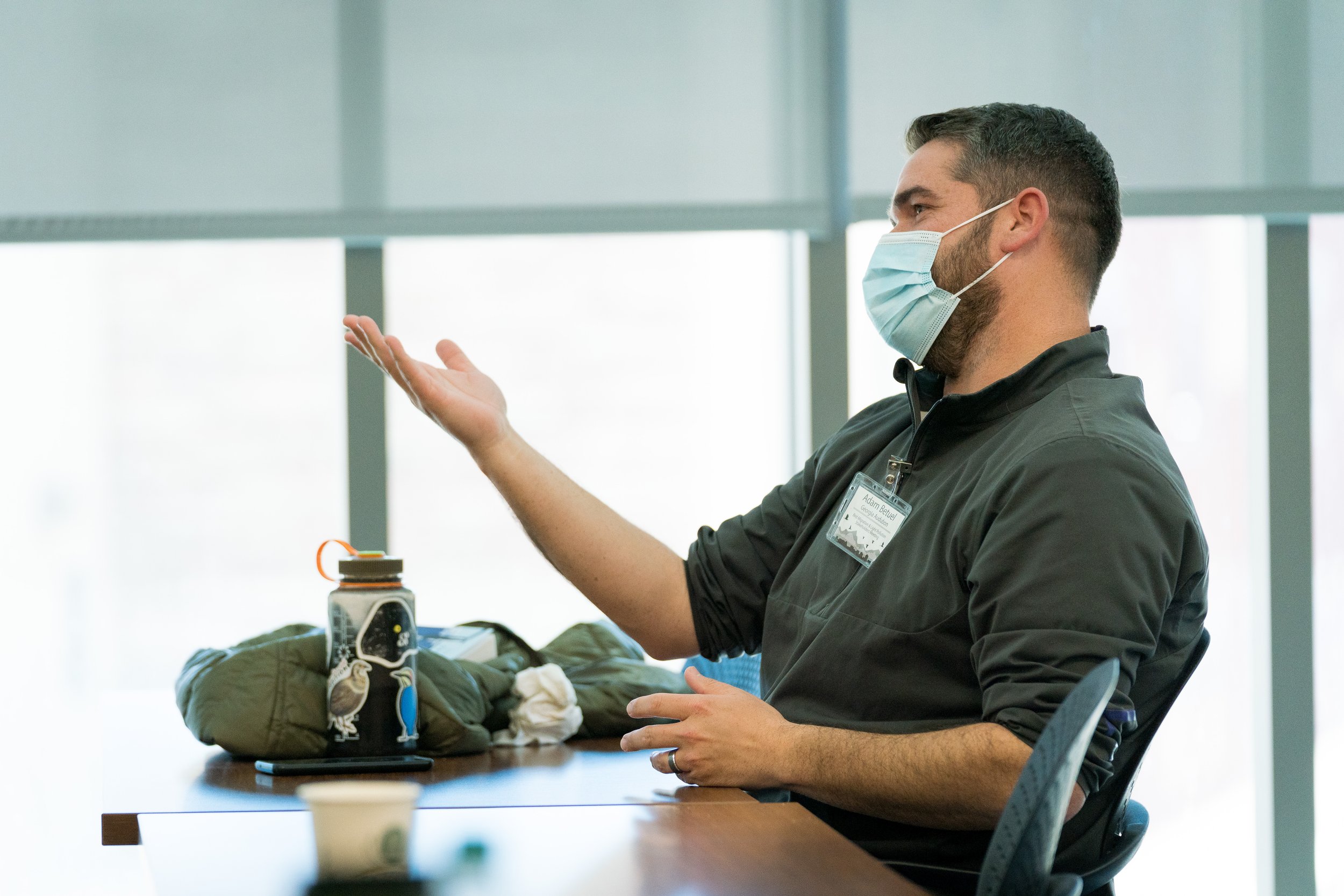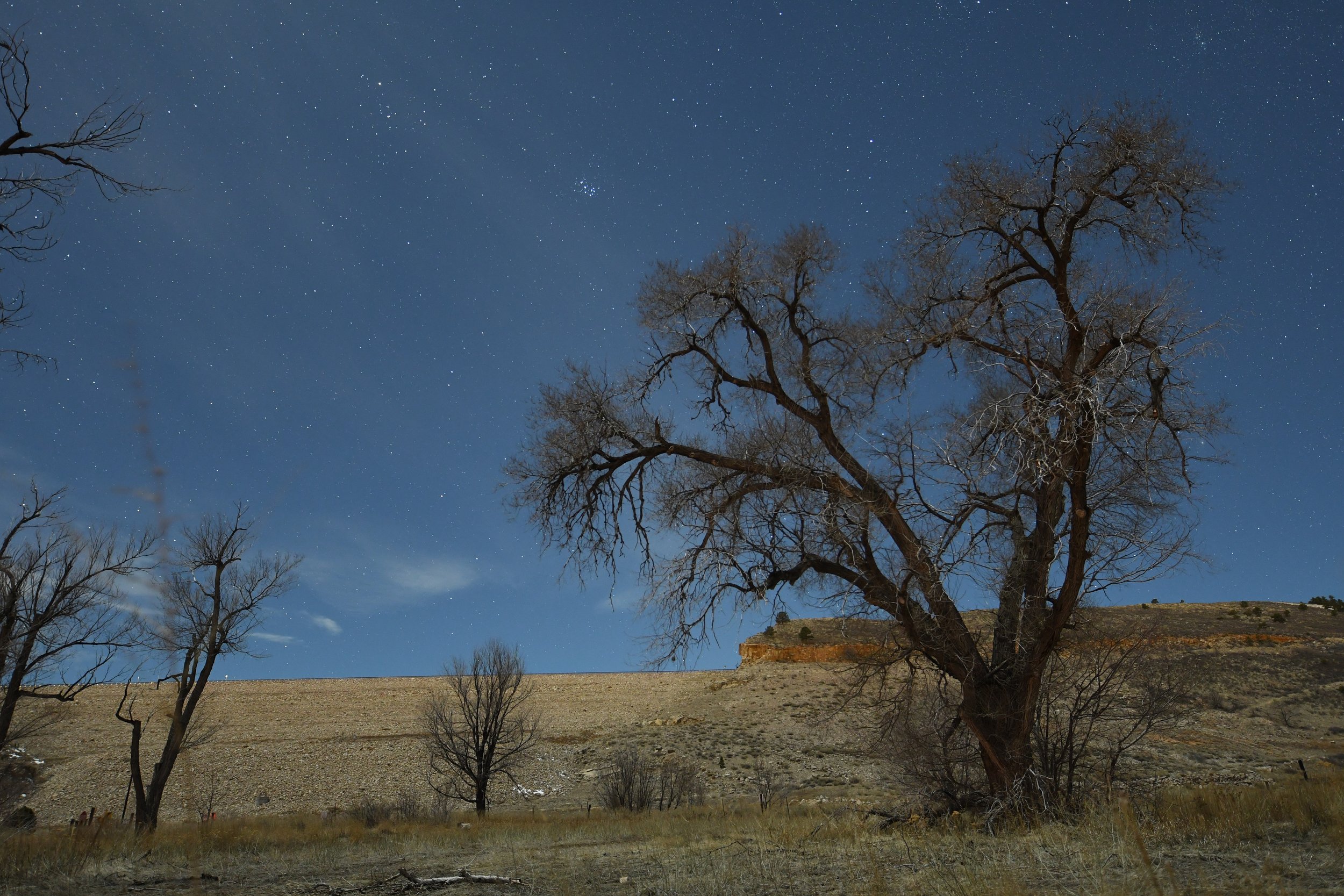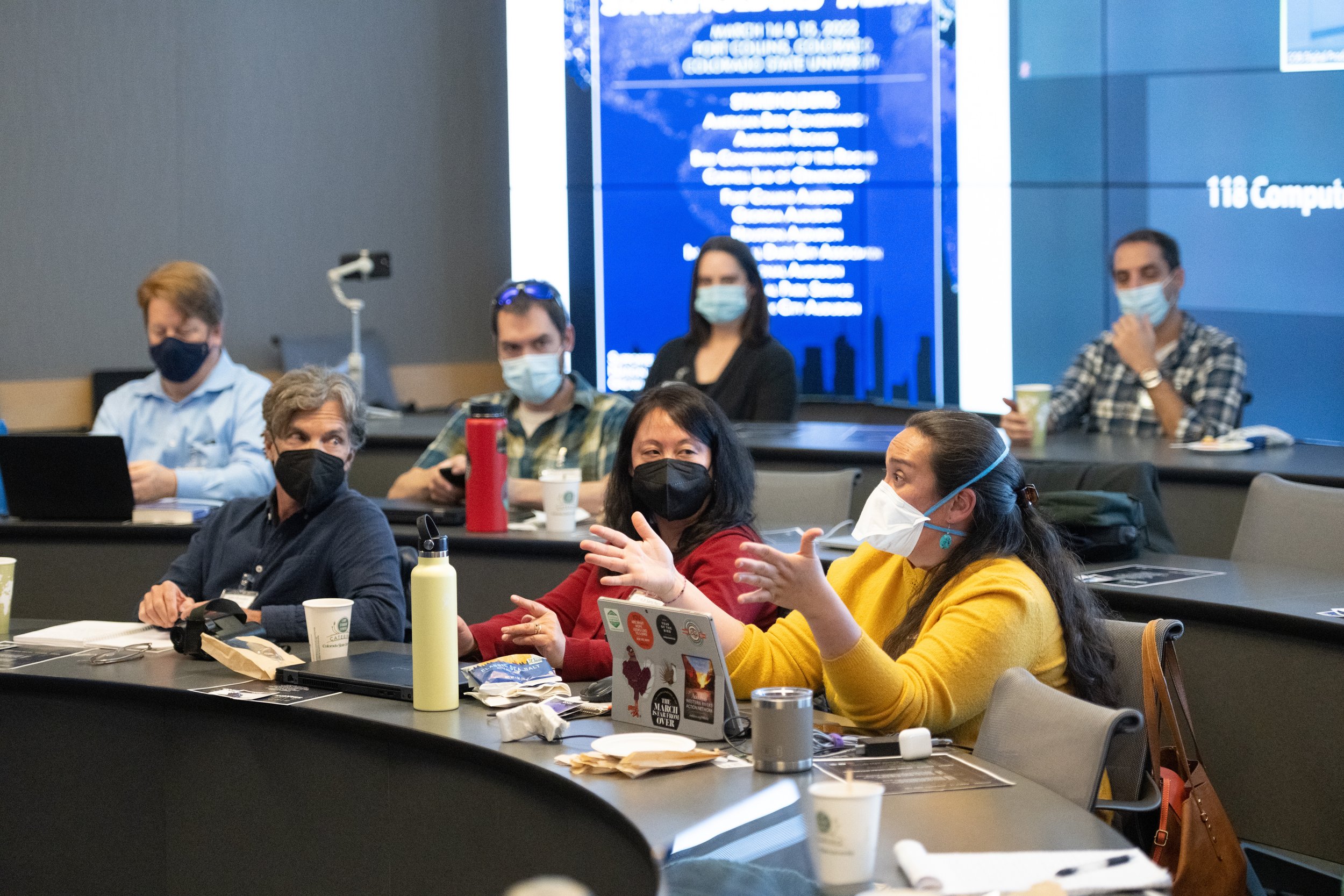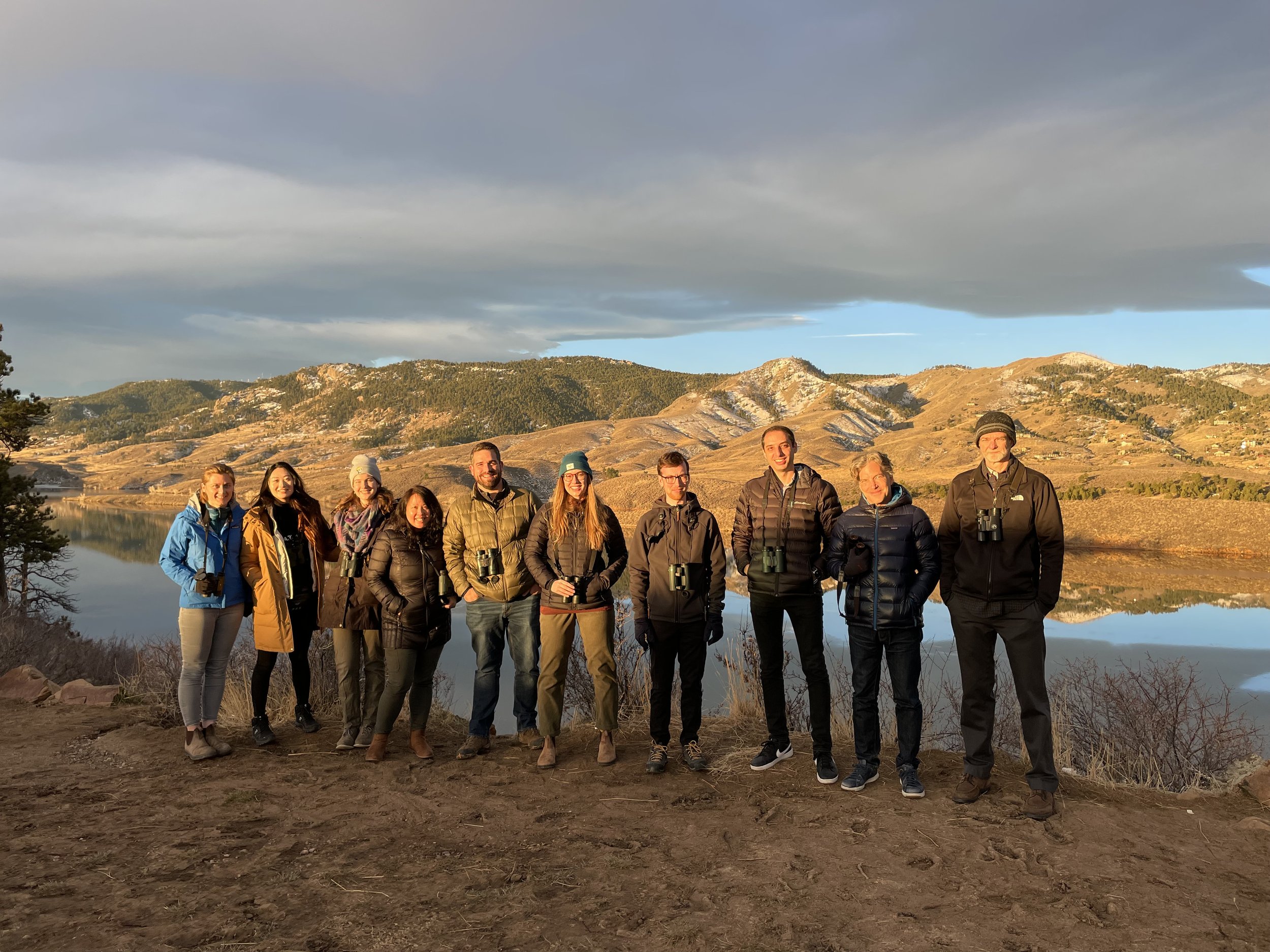Can improved ecological forecasting accelerate sustainability transformation in urban lighting?
Growing Convergence Research team at 2022 stakeholders meeting in Fort Collins, Colorado.
There is an urgent need for convergence research to accelerate sustainability transformations in complex socio-technological systems. Forecasting of earth systems and environmental conflicts with open environmental data is a national priority, in part, because of optimism that improved forecasts can accelerate sustainability transformations. However, little direct evidence connects improved ecological forecasting to sustainability transformations. Our team’s research project tests the prediction that improved ecological forecasts coupled with community engagement will accelerate sustainability transformation using proliferation of artificial lights at night (ALAN) as a testbed system. ALAN is increasing rapidly and emerging as a wicked environmental problem. Societal benefits derived from increases in ALAN, such as perceived safety or economic gains, are countered by pervasive negative consequences for ecological systems and human health. A major ecological consequence of ALAN is disruption of bird migration – millions of birds die annually in collisions with well-lit buildings – which contributes to widespread bird population declines. This project focuses on whether improved bird migration forecasts and increased community engagement accelerate sustainability transformations in ALAN.
“If we can make a lot of headway before a problem either becomes mired in politics or becomes a polarizing topic, the odds of a potential solution succeeding or being solved is considerably higher,” said Horton, a scientist in CSU’s Department of Fish, Wildlife and Conservation Biology. “As time passes and polarization sets in, it gets a lot more expensive to try and make headway.”
With support from an NSF Growing Convergence Research award across the University of Oklahoma (Norman, OK) and Colorado State University (Fort Collins, CO), our team works across disciplinary boundaries to tackle this wicked ecological and societal problem.
“Taking a transdisciplinary approach allows us to more wholly address both the ecological and social science aspects of light pollution by examining improved ecological forecasting, understanding the political landscape, and more broadly engaging with stakeholders and the public ”
Our Team
Dr. Jeff Kelly is a Professor of Biology at the University of Oklahoma.
Dr. Kyle Horton is an Assistant Professor of Fish, Wildlife, and Conversation Biology at Colorado State University.
Dr. Carol Silva is Co-Director of the Institute for Public Policy, Research, and Analysis and Edith Kinney Gaylord Presidential Professor of Political Science at the University of Oklahoma.
Dr. Hank Jenkins-Smith is Co-Director of the Institute for Public Policy, Research, and Analysis and a George Lynn Cross Professor of Political Science at the University of Oklahoma.
Dr. Andrew Fox is a Research Scientist at the Institute for Public Policy, Research, and Analysis at the University of Oklahoma.
Dr. Ali Khalighifar is a Postdoctoral Research Fellow in the Department of Fish, Wildlife, and Conservation Biology at Colorado State University.
Grace Trankina is a Master’s Student in Biology at the University of Oklahoma.
Dr. Maggie Chamberlain is a Postdoctoral Research Fellow at the Institute for Public Policy, Research, and Analysis at the University of Oklahoma.
Cheyenne Black is a Ph.D. student at the Institute for Public Policy, Research, and Analysis at the University of Oklahoma.
Dr. Carolyn Burt is a Convergence Coordinator in the Department of Fish, Wildlife, and Conservation Biology at Colorado State University.
Our Approach
We employ a transdisciplinary convergence approach across ecological, social, and political sciences. This convergence is guided by a new framework that integrates aspects of the Multi-Perspective Theory of socio-technological systems and the Advocacy Coalition Framework from the policy domain to understand the ALAN policy subsystem. The research plan will: (1) gather detailed national survey information on the ALAN system; (2) create transformational technological improvements in existing bird migration forecasts specific to impacts of ALAN; (3) engage with advocacy coalitions in specific communities – Houston, Atlanta, Fort Collins, and Oklahoma City – to implement sustainability transformation experiments using targeted messaging campaigns; and (4) measure the impact of improved ecological forecasting and community engagement on proliferation of ALAN, on migrant birds, and human behaviors and attitudes toward ALAN. Results will create new, and potentially transformative, understanding of how ecological forecasting can contribute to sustainability transformations.
Year 1 Stakeholders Meeting
(Fort Collins, CO)
To kick-off this effort, our GCR Team hosted a Bird Migration and Light Pollution Stakeholders Workshop on March 13 and 14, 2022 at Colorado State University. We hosted representatives from the following organizations: American Bird Conservancy, Audubon Rockies, Bird Conservancy of the Rockies, Cornell Lab of Ornithology, Fort Collins Audubon, Georgia Audubon, Houston Audubon, International Dark-Sky Association, National Audubon, National Park Service, and New York City Audubon. Over the two days we enjoyed symposia by the majority of the stakeholders and discussed how to address this wicked problem together in brainstorming groups. We also converged around our research approach by receiving input from stakeholders on both our national survey and ecological forecasting products. We concluded the workshop with a plenary seminar by Paul Bogard, author of “The End of Night.”
Broader Impacts
Transdisciplinary Convergence Seminar
We hosted a 1-credit, graduate-level seminar course between the University of Oklahoma and Colorado State University. We designed the seminar to explore best practices and examples of transdisciplinary convergence research for solving complex socio-ecological problems. We invited experts and investigators who moved beyond discipline-specific approaches to address a common problem to lead seminar discussions. For example, over the course of the semester, we discussed the complexity and humility in rangeland science in working with stakeholders, how to implement deliberative engagement across polarized groups, the economics of animal migration, and many other topics. Common themes we focused on throughout the semester included defining what transdisciplinary convergence looks like, how to implement or initiate convergence research programs, barriers to achieving convergence, and funding opportunities for convergence research.
Our students also came from diverse academic backgrounds including anthropology, ecology, biology, geosciences, human dimensions of natural resources, and wildlife biology. We administered a pre- and post-survey to measure growth in knowledge around transdisciplinary convergence research. At the beginning of the seminar, 56% of students were confident they could explain what a transdisciplinary research approach meant, but by the end of the semester, 100% of the students were confident they could explain this research approach to a peer. Similarly, 20% of students could name funding sources for convergence, but by the end of the seminar course, 100% of students were able to name one or multiple sources at the NSF.
“Beyond the challenges and approaches, I take away a new framework for critical thinking about a problem through more than just the lenses that I am equipped to look through. I can consider the way that others could contribute to solve a problem and to ask others for their expertise on an issue. This seminar broadened the scope of my inquiry as a researcher, who regularly interacts with several different disciplines.”
—Fall 2022 Seminar Series—
Transdisciplinary perspectives on artificial-lights-at-night and achieving sustainable night skies
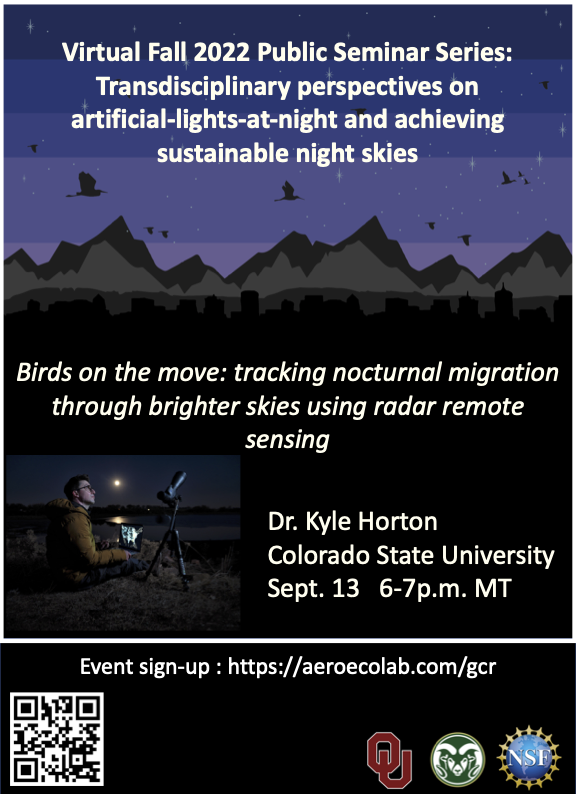

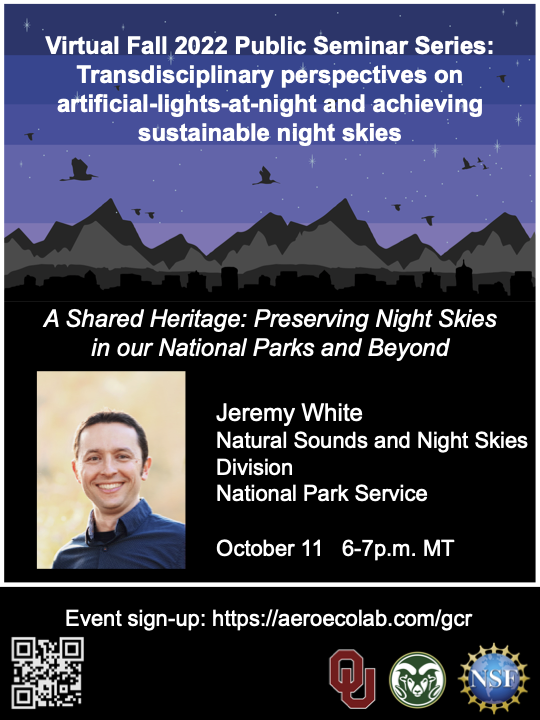
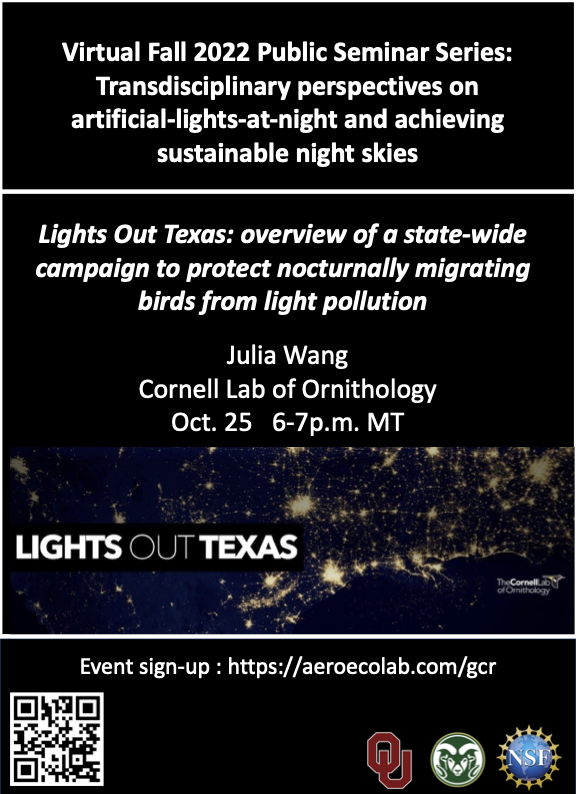
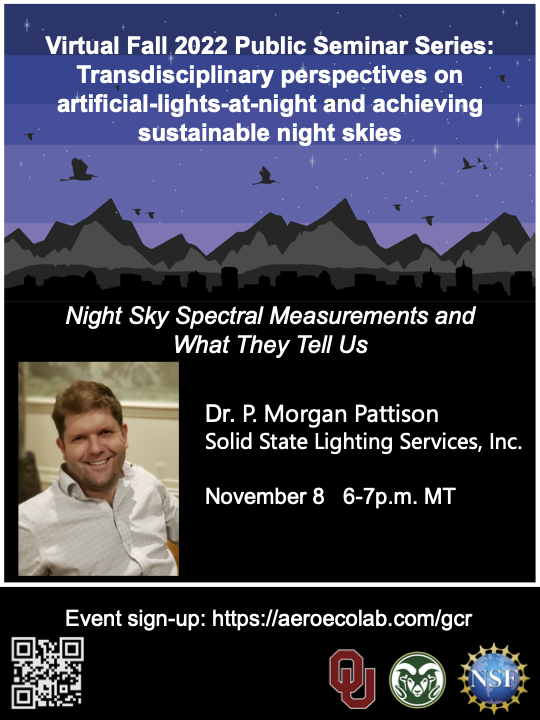
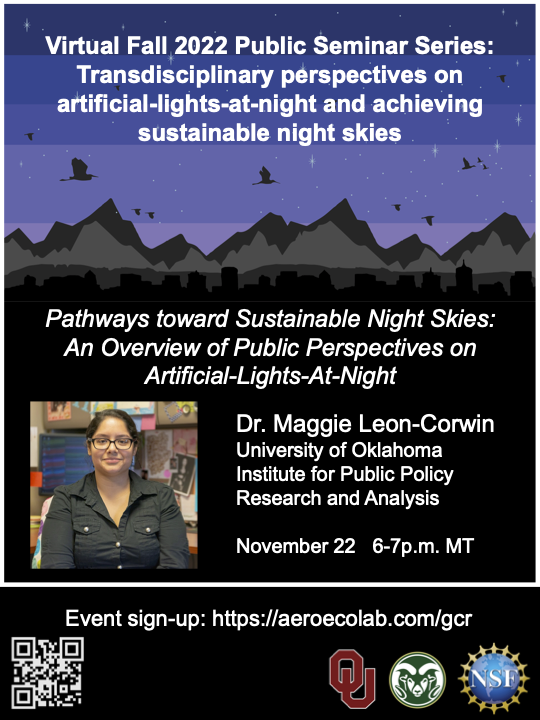
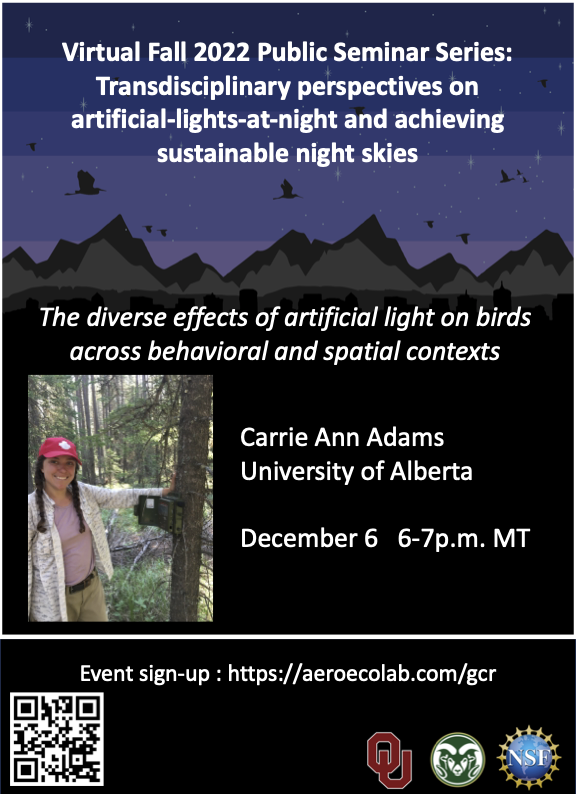
Artificial-lights-at-night (ALAN) is increasing rapidly worldwide and has negative impacts on ecosystems and human health. However, ALAN is also important to the economic life of cities and people's perception of safety at night. This fall, our research team hosted a virtual public seminar series exploring multiple perspectives on ALAN and search for ways to achieve sustainable nighttime skies. This series spanned a range of topics, including the preservation of night skies, bird collisions, social perceptions and attitudes of light pollution, policy, community science, and technological tools for effective mitigation measures. We hosted seven sessions of this virtual series over Zoom (6:00-7:00 MT) every other Tuesday from September 13th, 2022, to December 6th, 2022. We had a total of 587 registrations for this seminar series with 326 attendees across all seven seminars. We had broad engagement across the series with attendees tuning in from 21 states across the U.S, 7 provinces in Canada, and 1 city in the U.K.
Presenter Summaries:
Dr. Kyle Horton — Colorado State University
Birds on the move: tracking nocturnal migration through brighter skies using radar remote sensing
Global prevalence of artificial lights at night (ALAN) is increasing rapidly and one ecological consequence of ALAN is disruption of bird migration, which contributes to widespread bird population declines. Dr. Horton will present advances made in our ability to forecast migratory movements through the growth of biological and spatial covariates quantifying terrestrial and atmospheric conditions at local and macroscales. Additionally, Dr. Horton will highlight our stakeholder coalition framework for growing convergence research.
Dr. Travis Longcore — UCLA Institute of the Environment and Sustainability
Practical Strategies to Reduce Adverse Effects of Artificial Light at Night
Even as we continue to learn the extent and importance of the adverse effects of artificial light at night on other species and our own, we need practical guidance to reduce those impacts now. Dr. Longcore will report on both basic research and applied projects with lighting professionals and urban planners that demonstrate viable approaches to light pollution mitigation that can be implemented immediately.
Jeremy White — National Park Service, Natural Sounds and Night Skies Division
A Shared Heritage: Preserving Night Skies in our National Parks and Beyond
Across our National Parks, starry night skies serve as more than just a scenic backdrop. Natural night skies are an integral part of our shared natural, cultural and historic park resources. Jeremy White of the NPS Natural Sounds and Night Skies Division will discuss the efforts of the Natural Park Service to preserve and restore night sky resources in our parks and beyond.
Julia Wang — Cornell Lab of Ornithology
Lights Out Texas: overview of a state-wide campaign to protect nocturnally migrating birds from light pollution
Every spring and fall, billions of birds migrate through the US, mostly under the cover of darkness. This mass movement of birds must contend with a dramatically increasing but still largely under-recognized threat: light pollution. Julia Wang of the Cornell Lab of Ornithology will discuss efforts to implement practical conservation action through the case of Lights Out Texas, a state-wide effort to protect birds from the adverse effects of artificial light at night.
Dr. P. Morgan Pattison — Solid State Lighting Services, Inc.
Night Sky Spectral Measurements and What They Tell Us
We have made baseline measurements of absolute, spectrally resolved night sky radiance. This data provides a baseline of the nightime lightscape at a given location and can be used to determine the contributing lighting technologies to light at night, so that changes can be seen with subsequent measurements. The data can also be analyzed for atmospheric spectral scattering effects.
Dr. Maggie Leon-Corwin — University of Oklahoma, Institute for Public Policy Research and Analysis
Pathways toward Sustainable Night Skies: An Overview of Public Perspectives on Artificial-Lights-At-Night
In this seminar, Dr. Leon-Corwin will provide a summary of preliminary findings from a nation-wide, representative survey that seeks to understand public views on the impact of artificial-lights-at-night on society and the environment. Public perceptions of pathways toward sustainable night skies and light pollution reduction techniques will be emphasized.
Carrie Ann Adams — University of Alberta
The diverse effects of artificial light on birds across behavioral and spatial contexts
Diverse bird responses across many taxa suggest high costs but some benefits of artificial light. Carrie Ann Adams of the University of Alberta will discuss how artificial light can contribute to bird collisions and mortality by attracting or disorienting them, deter birds from zones of human-wildlife conflict, and affect their habitat selection when not in flight. Artificial light is thought to benefit birds that eat flying insects by attracting their insect prey, yet habitat use patterns in nightjars in western Canada show that this foraging behavior only benefits some species in particular contexts, and likely harms them when nesting. On the whole, reducing light pollution is likely to benefit nightjars and other bird species.
Presentations
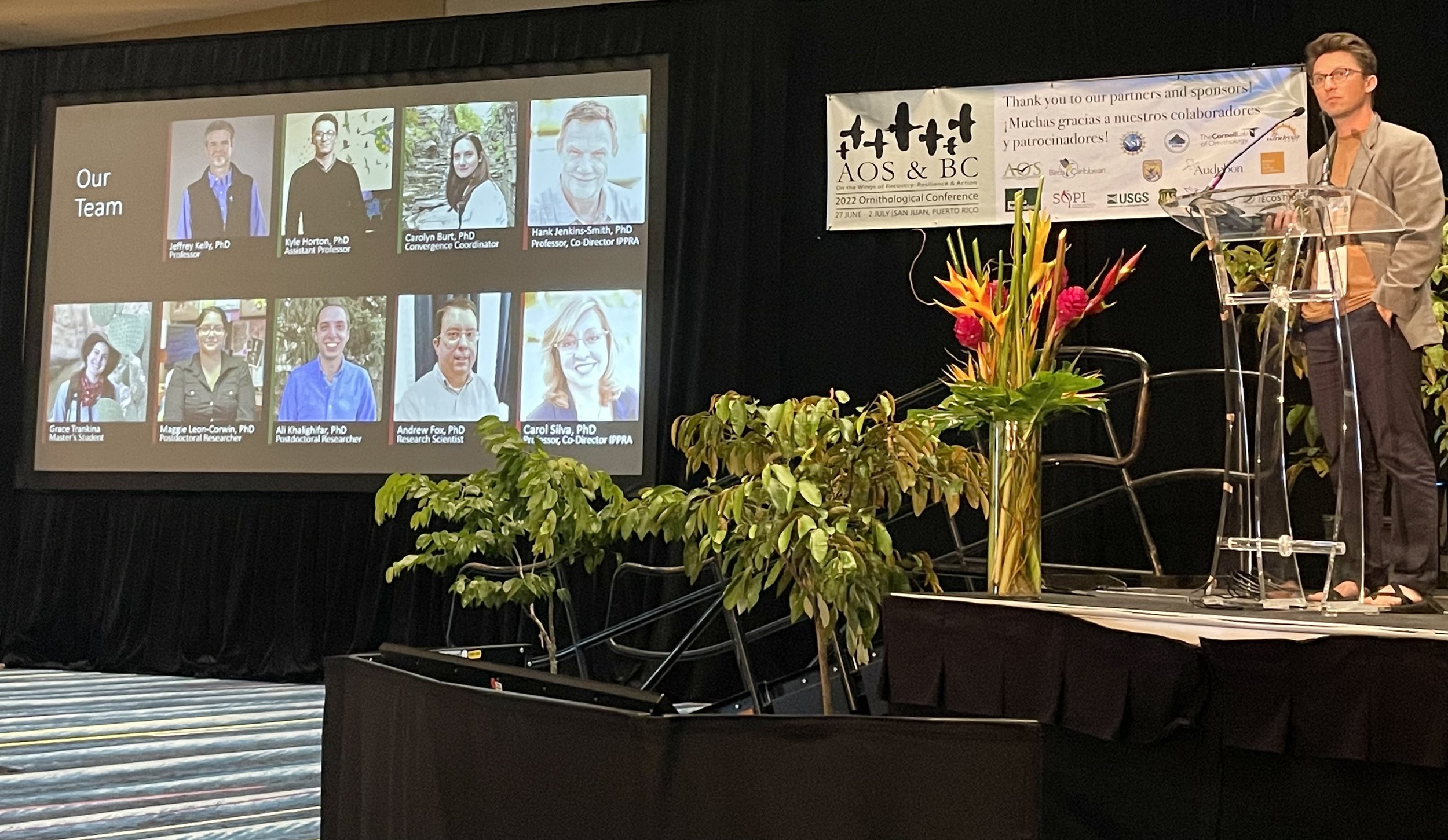
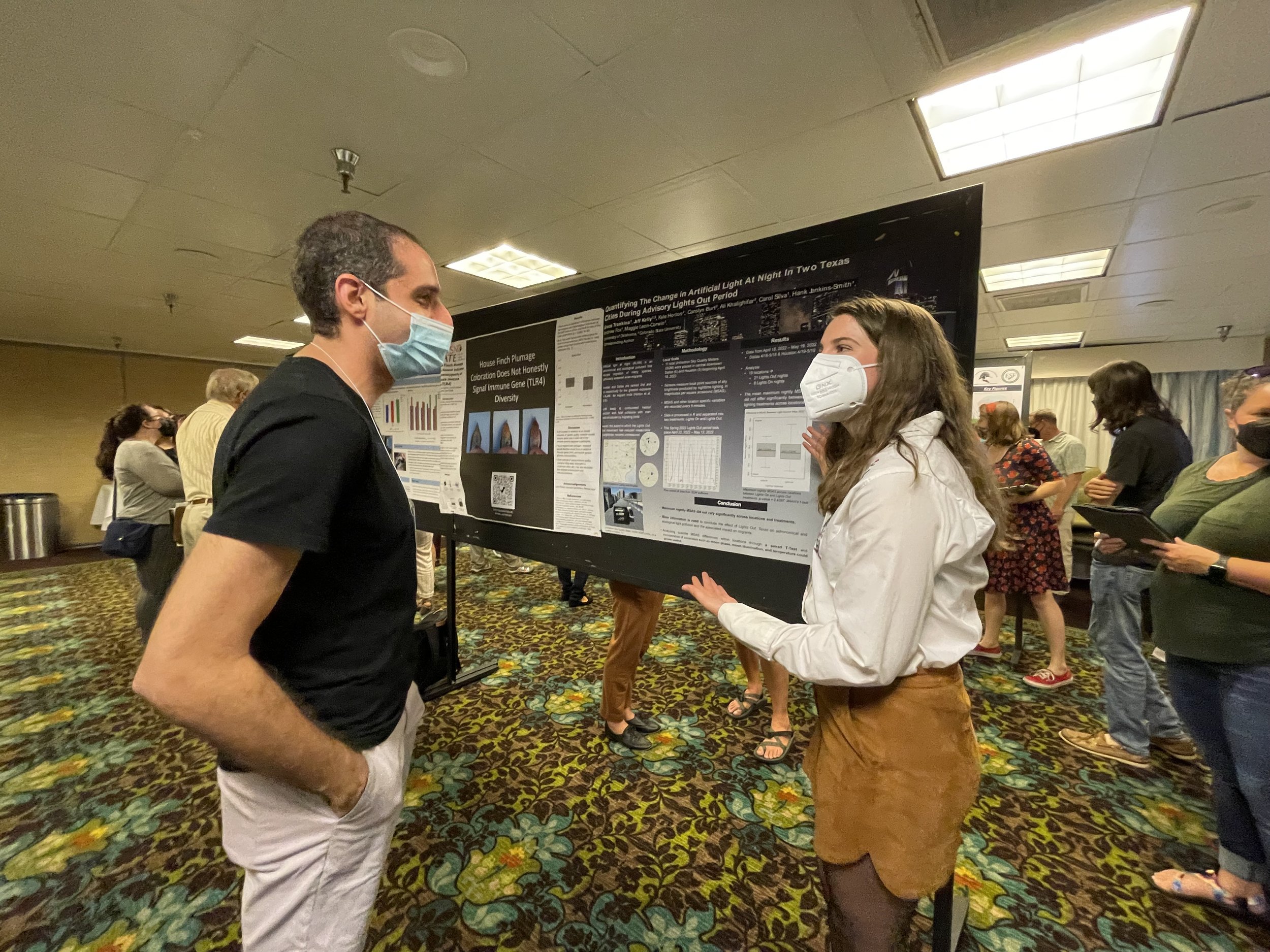
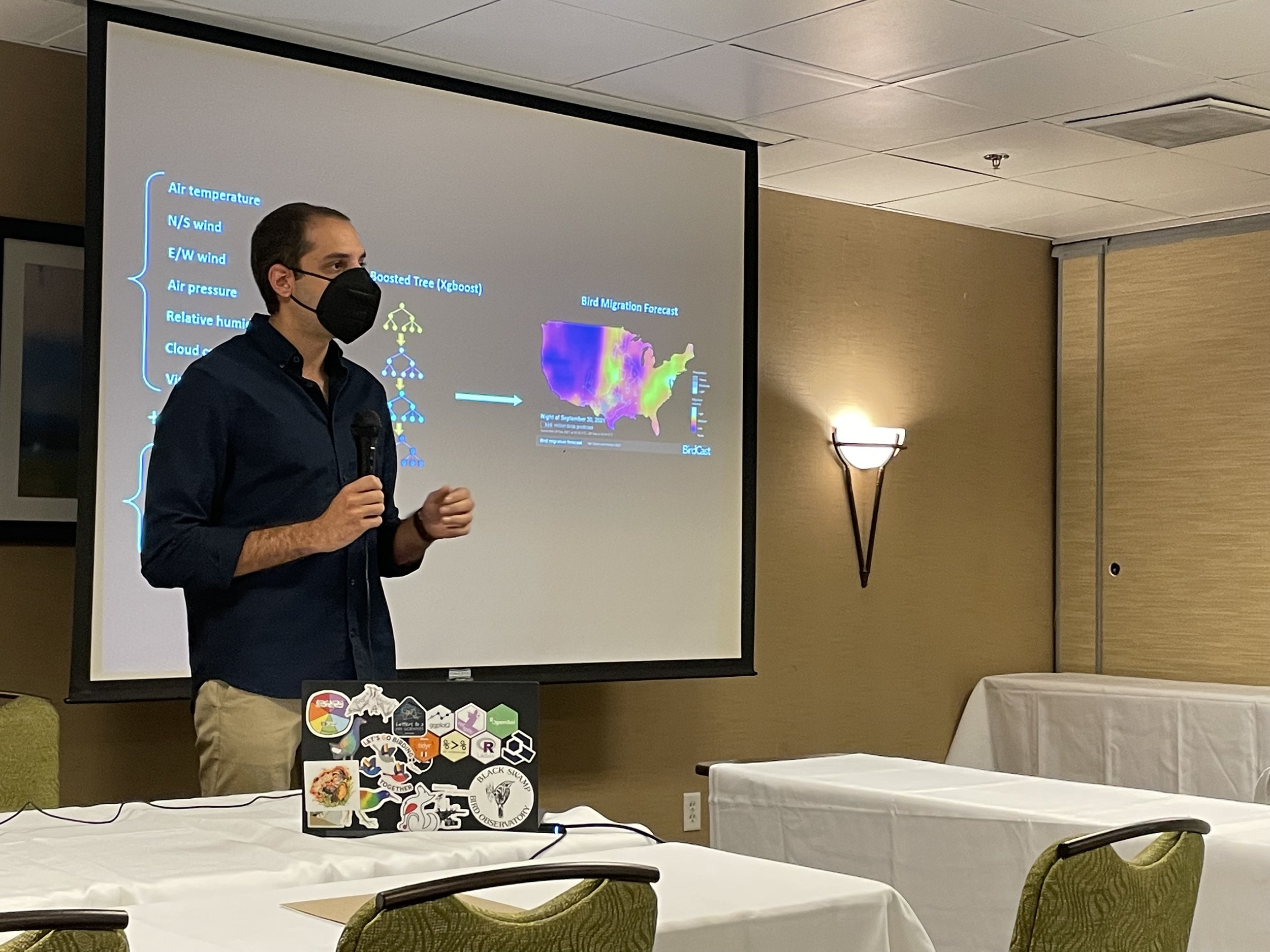
Media Coverage
Night Skies Are Even Brighter Than We Thought — and Getting Brighter. Audubon Magazine 🔗
In the dark: Study reveals need for better understanding of light pollution on migrating animals. What’s hot in science and engineering? National Science Foundation’s Research News 🔗
NSF Features Research Study Published by OU Biologists, Social Scientists. University of Oklahoma Research Insider 🔗
IN THE DARK Study reveals need for better understanding effects of light pollution on migrating animals. Colorado State University SOURCE 🔗
Trying to Find Your Place in the World? Try Birding From a Different Angle. The New York Times Magazine 🔗
Light Pollution and Migrating Birds – A Conservation Scientist Weighs In. Design Lights Consortium Perspective Article 🔗
Publications
- Abbott, A. L., Y. Deng, K. Badwey, A. Farnsworth, K. G. Horton. Inbound arrivals: Using weather surveillance radar to quantify the diurnal timing of spring trans-Gulf bird migration. 2023. Ecography. In Press.
- Burt, C. S., J. F. Kelly, A. S. Fox, H. C. Jenkins-Smith, M. Leon-Corwin, A. Khalighifar, G. E. Trankina, C. L. Silva, and K. G. Horton. Can ecological forecasting lead to convergence on sustainable lighting policies? 2023. Conservation Science and Practice. 🔗
- Loss, S., B. Li, L. Horn, M. Mesure, L. Zhu, T. Brys, A. Dokter, J. Elmore, R. Gibbons, T. Homayoun, K. G. Horton, P. Inglet, B. Jones, T. Keys, S. Lao, S. Loss, K. Parkins, H. Prestridge, G. Riggs, C. Riding, K. Sweezey, A. Vallery, B. Van Doren, J. Wang, C. Zuzula, A. Farnsworth. Citizen science to address the global issue of bird-window collisions. 2023. Frontiers in Ecology and the Environment. 🔗
- Burt, C. S., J. F. Kelly, G. E. Trankina, C. L. Silva, A. Khalighifar, H. C. Jenkins-Smith, A. S. Fox, K. M. Fristrup, and K. G. Horton. The effects of light pollution on migratory animal behavior. 2023. Trends in Ecology & Evolution. 🔗
- La Sorte, F. A., K. G. Horton, A. Johnston, D. Fink, and T. Auer. Seasonal associations with light pollution trends for nocturnally migrating bird populations. 2022. Ecosphere. 🔗
- La Sorte, F. A., M. Aronson, C. Lepczyk, K. G. Horton, Assessing the combined threats of artificial light at night and air pollution for the world’s nocturnally migrating birds. 2022. Global Ecology and Biogeography. 🔗



